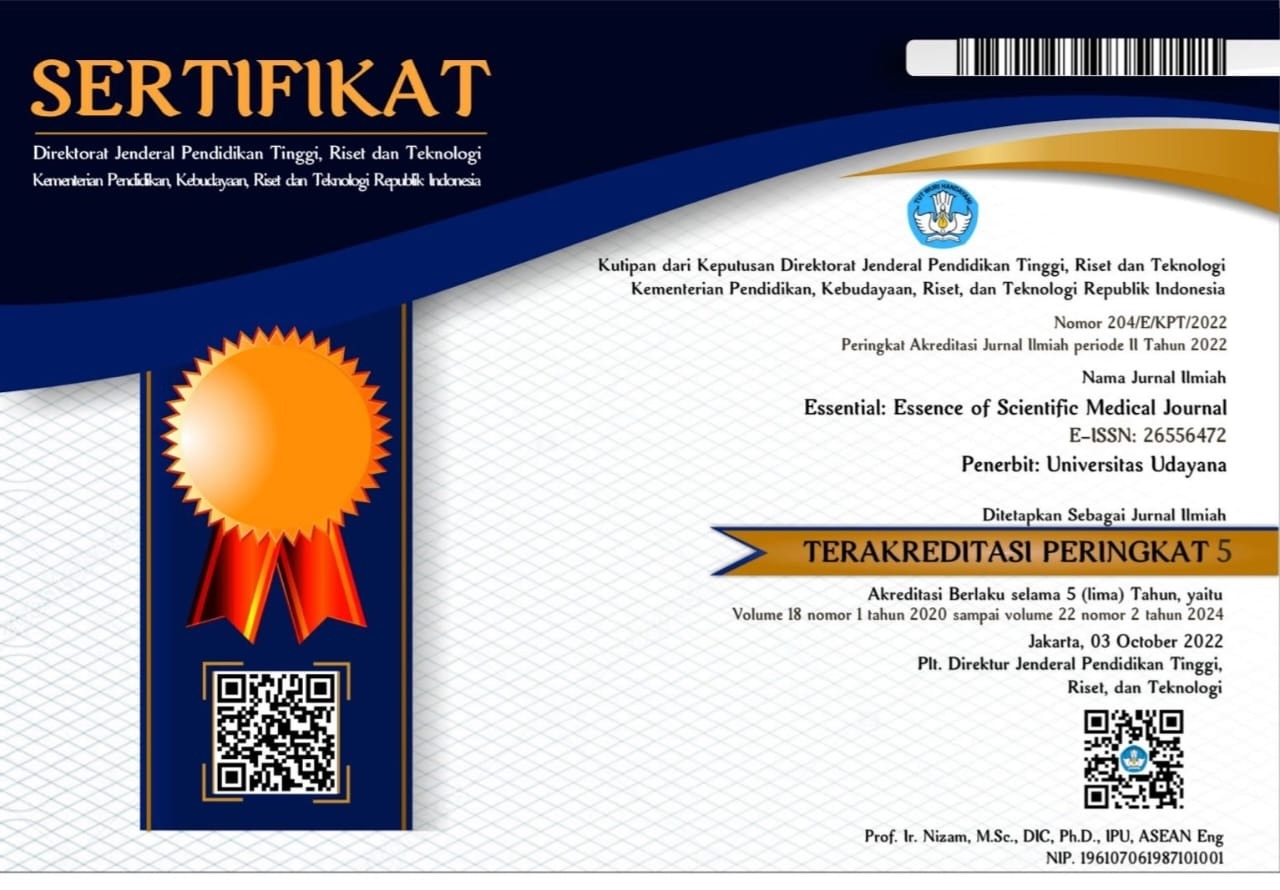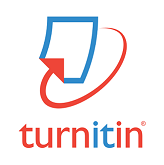Potensi Photodynamic Therapy (PDT) Berbasis Inhalable Curcumin sebagai Modalitas Terapi COVID-19
Abstract
Pendahuluan: COVID-19 telah menjadi krisis kesehatan baru yang mengancam dunia. Upaya preventif seperti edukasi dan vaksinasi telah dilakukan. Satu-satunya pilihan yang tersedia adalah penggunaan obat antivirus spektrum luas, tetapi beberapa obat tersebut cenderung mahal dan memiliki efek samping yang berbahaya. Curcumin memiliki efek terapeutik potensial untuk COVID-19 karena efek antivirus dan anti-inflamasinya. Curcumin dapat dikemas dalam bentuk inhalable dengan memformulasinya menjadi bubuk kering. Penggunaan photodynamic therapy (PDT) dapat meminimalisasi toksisitas sistemik dan efek samping yang tidak diinginkan.
Pembahasan: Curcumin telah terbukti menghambat replikasi virus dengan menghambat glikoprotein S dan ACE 2, menghambat aksi TMPRSS2, Main protease (Mpro), dan menurunkan ekspresi pompa vakuolar (ATPase). Curcumin juga dapat menurunkan respon inflamasi dengan menghambat aktivasi translokasi NF-kB yang dimediasi STAT3. Formulasi terapi inhalasi Curcumin sebagai produk serbuk kering dapat meningkatkan bioavailabilitas Curcumin dan kepatuhan pasien. Curcumin-PDT pada sel Vero yang terinfeksi SARS-CoV2 memberikan efek anti-COVID-19 secara in vitro tanpa menyebabkan sitotoksisitas dan apoptosis dalam sel, dan tidak memiliki efek buruk pada kualitas plasma.
Simpulan: Inhalable Curcumin berbasis terapi fotodinamik berpotensi sebagai inovasi terapi COVID-19.
Downloads
References
2. Co H, Nazmiye Y, Gündüz S. Science of the Total Environment The spread of COVID-19 virus through population density and wind in Turkey cities. 2021;751.
3. World Health Organization. Available online: https://www.who.int/emergencies/diseases/novel-coronavirus-2019 (accessed on 07 Agustus 2020).
4. Covid19 (2020) Peta Sebaran Available online: https://covid19.go.id/peta-sebaran (accessed on 11 Agustus 2020).
5. Rothan HA, Byrareddy SN. The epidemiology and pathogenesis of coronavirus disease ( COVID-19 ) outbreak. J Autoimmun [Internet]. 2020;(February):102433. Available from: https://doi.org/10.1016/j.jaut.2020.102433
6. Gennaro F Di, Pizzol D, Marotta C, Antunes M, Racalbuto V, Veronese N, et al. Coronavirus Diseases ( COVID-19 ) Current Status and Future Perspectives : A Narrative Review. J Environ Res Public Heal. 2020;(September 2012).
7. Zumla A, Hui D, Azhar E, Memish Z, Maeurer M. Reducing mortality from 2019-nCoV: host-directed therapies should be an option. Lancet. 2020;395(January):35–6.
8. Belizário JE. Immunity, virus evolution, and effectiveness of SARS-CoV-2 vaccines. Brazilian Journal of Medical and Biological Research. 2021 Mar 15;54
9. M. Wang, R. Cao, L. Zhang, X. Yang, J. Liu, M. Xu, et al., Remdesivir and Chloroquine Effectively Inhibit the Recently Emerged Novel Coronavirus (2019- nCoV) in Vitro, Cell research, 2020.
10. Tang D, Li J, Zhang R, Kang R, Klionsky DJ. Chloroquine in fighting COVID-19: good, bad, or both?. Autophagy. 2020 Dec 1;16(12):2273-5.
11. Chitalia VC, Munawar AH. A painful lesson from the COVID-19 pandemic: the need for broad-spectrum, host-directed antivirals. Journal of translational medicine. 2020 Dec;18(1):1-6
12. Silalahi M. PEMANFAATAN Curcuma longa (L.) OLEH MASYARAKAT LOKAL DI INDONESIA DAN KANDUNGAN METABOLIT SEKUNDERNYA. Jurnal Pro-Life: Jurnal Pendidikan Biologi, Biologi, dan Ilmu Serumpun. 2017 Oct 19;4(3):430-40.
13. Syamsudin RA, Perdana F, Mutiaz FS. TANAMAN TEMULAWAK (Curcuma xanthorrhiza Roxb) SEBAGAI OBAT TRADISIONAL. Jurnal Ilmiah Farmako Bahari. 2019 Jan 21;10(1):51-65.
14. Zorofchian Moghadamtousi S, Abdul Kadir H, Hassandarvish P, Tajik H, Abubakar S, Zandi K. A review on antibacterial, antiviral, and antifungal activity of curcumin. Biomed Res Int. 2014;2014.
15. Cheng K, Yang A, Hu X, Zhu D, Liu K. Curcumin attenuates pulmonary inflammation in lipopolysaccharide induced acute lung injury in neonatal rat model by activating peroxisome proliferator-activated receptor γ (PPARγ) pathway. Med Sci Monit. 2018;24:1178–84.
16. Sahebkar A, Cicero AFG, Simental-Mendía LE, Aggarwal BB, Gupta SC. Curcumin downregulates human tumor necrosis factor-α levels: A systematic review and meta-analysis ofrandomized controlled trials. Pharmacol Res [Internet]. 2016;107:234–42. Available from: http://dx.doi.org/10.1016/j.phrs.2016.03.026
17. Derosa G, Maffioli P, Simental-Mendía LE, Bo S, Sahebkar A. Effect of curcumin on circulating interleukin-6 concentrations: A systematic review and meta-analysis of randomized controlled trials [Internet]. Vol. 111, Pharmacological Research. Elsevier Ltd; 2016. 394–404 p. Available from: http://dx.doi.org/10.1016/j.phrs.2016.07.004
18. Ma Z, Wang N, He H, Tang X. Pharmaceutical strategies of improving oral systemic bioavailability of curcumin for clinical application. Journal of Controlled Release. 2019 Dec 28;316:359-80.
19. Chvatal A. Formulation and aerodynamic evaluation of carrier-free dry powder inhalation systems containing meloxicam. International Journal of Pharmaceutics. 2019;559:68-75.
20. Pourhajibagher M, Azimi M, Haddadi-asl V, Ahmadi H. Robust antimicrobial photodynamic therapy with curcumin-poly (lactic-co-glycolic acid) nanoparticles against COVID-19: A preliminary in vitro study in Vero cell line as a model. Photodiagnosis Photodyn Ther. 2021;34(1–12).
21. Alves LA, Ferreira LB, Pacheco PF, Mendivelso EA, Teixeira PC, Faria RX. Pore forming channels as a drug delivery system for photodynamic therapy in cancer associated with nanoscintillators. Oncotarget. 2018 May 18;9(38):25342.
22. Susilo A, Rumende CM, Pitoyo CW, Santoso WD, Yulianti M, Sinto R, et al. Coronavirus Disease 2019 : Tinjauan Literatur Terkini Coronavirus Disease 2019 : Review of Current Literatures. 2020;7(1):45–67.
23. Wang Z, Qiang W, Ke H. A Handbook of 2019-nCoV Pneumonia Control and Prevention. Hubei Sci Technol Press. 2020;1–108.
24. Roberts N, Brown R, Buja L, Weerasinghe P. Molecular Mechanisms of Curcumin in COVID-19 Treatment and Prevention: A Global Health Perspective. Med Res Arch. 2020;8(10).
25. Zhang T, Wu Q, Zhang Z. Probable Pangolin Origin of SARS-CoV-2 Associated with the COVID-19 Outbreak. Curr Biol. 2020;30(7):1346-1351.e2.
26. Li G, Fan Y, Lai Y, Han T, Li Z, Zhou P, et al. Coronavirus infections and immune responses. J Med Virol [Internet]. 2020;92(4):424–32. Available from: http://dx.doi.org/10.1002/jmv.25685
27. Li X, Geng M, Peng Y, Meng L, Lu S. Molecular immune pathogenesis and diagnosis of COVID-19. J Pharm Anal [Internet]. 2020;10(2):102–8. Available from: https://doi.org/10.1016/j.jpha.2020.03.001
28. Wang C, Horby PW, Hayden FG, Gao GF. A novel coronavirus outbreak of global health concern. Lancet. 2020;395(10223):470–3.
29. Soleimani V, Sahebkar A, Hosseinzadeh H. Turmeric (Curcuma longa) and its major constituent (curcumin) as nontoxic and safe substances: Review. Phyther Res. 2018;32(6):985–95.
30. Akbar MU, Rehman K, Zia KM, Qadir MI, Akash MSH, Ibrahim M. Critical review on curcumin as a therapeutic agent: From traditional herbal medicine to an ideal therapeutic agent. Crit Rev Eukaryot Gene Expr. 2018;28(1):17–24.
31. Fan Z, Yao J, Li Y, Hu X, Shao H, Tian X. Anti-inflammatory and antioxidant effects of curcumin on acute lung injury in a rodent model of intestinal ischemia reperfusion by inhibiting the pathway of NF-Kb. Int J Clin Exp Pathol. 2015;8(4):3451–9.
32. Zhu JY, Yang X, Chen Y, Jiang Y, Wang SJ, Li Y, et al. Curcumin Suppresses Lung Cancer Stem Cells via Inhibiting Wnt/β-catenin and Sonic Hedgehog Pathways. Phyther Res. 2017;31(4):680–8.
33. Pillaiyar T, Manickam M, Namasivayam V, Hayashi Y, Jung S-H. An overview of severe acute respiratory syndrome–coronavirus (SARS-CoV) 3CL protease inhibitors: peptidomimetics and small molecule chemotherapy. J Med Chem. 2016;59(14):6595–628.
34. Łoczechin A, Séron K, Barras A, Giovanelli E, Belouzard S, Chen YT, et al. Functional Carbon Quantum Dots as Medical Countermeasures to Human Coronavirus. ACS Appl Mater Interfaces. 2019;11(46):42964–74.
35. Lin CJ, Chang L, Chu HW, Lin HJ, Chang PC, Wang RYL, et al. High Amplification of the Antiviral Activity of Curcumin through Transformation into Carbon Quantum Dots. Small. 2019;15(41):1–14.
36. Palizgir MT, Akhtari M, Mahmoudi M, Mostafaei S, Rezaiemanesh A, Shahram F. Curcumin reduces the expression of interleukin 1β and the production of interleukin 6 and tumor necrosis factor alpha by M1 macrophages from patients with Behcet’s disease. Immunopharmacol Immunotoxicol [Internet]. 2018;40(4):297–302. Available from: https://doi.org/10.1080/08923973.2018.1474921
37. Ferreira VH, Nazli A, Dizzell SE, Mueller K, Kaushic C. The anti-inflammatory activity of curcumin protects the genital mucosal epithelial barrier from disruption and blocks replication of HIV-1 and HSV-2. PLoS One. 2015;10(4):1–18.
38. Yallapu MM, Jaggi M, Chauhan SC. Curcumin nanoformulations: A future nanomedicine for cancer. Drug Discov Today. 2012;17:71–80.
39. Chaturvedi NP, Solanki H. Pulmonary drug delivery system: Review. Int J Appl Pharm. 2013;5:7–10.
40. Kurniawansyah F, Mammucari R, Foster NR. Inhalable curcumin formulations by supercritical technology. Powder Technol [Internet]. 2015;284:289–98. Available from: http://dx.doi.org/10.1016/j.powtec.2015.04.083
41. Wu X, Hayes DJ, Zwischenberger JB, Kuhn RJ, Mansour HM. Design and physicochemical characterization of advanced spray-dried tacrolimus multifunctional particles for inhalation. Drug Des Devel Ther. 2013;7:59–72.
42. Kankala RK, Zhang YS, Wang S, Lee C, Chen A. Supercritical fluid technology: an emphasis on drug delivery and related biomedical applications. Adv Healthc Mater. 2017;6(16):1700433.
43. Xu F, Song J, Xu B, Wang J, Mao J, Liu H, et al. Clinical study of systemic chemotherapy combined with bronchoscopic interventional cryotherapy in the treatment of lung cancer. BMC Cancer. 2020 Nov;20(1):1089.
44. Liang Z, Ni R, Zhou J, Mao S. Recent advances in controlled pulmonary drug delivery. Drug Discov Today [Internet]. 2015;20(3):380–9. Available from: http://dx.doi.org/10.1016/j.drudis.2014.09.020
45. Abdelaziz HM, Gaber M, Abd-Elwakil MM, Mabrouk MT, Elgohary MM, Kamel NM, et al. Inhalable particulate drug delivery systems for lung cancer therapy: Nanoparticles, microparticles, nanocomposites and nanoaggregates. J Control release. 2018;269:374–92.
46. Zhang J, Wu L, Chan HK, Watanabe W. Formation, characterization, and fate of inhaled drug nanoparticles. Adv Drug Deliv Rev [Internet]. 2011;63(6):441–55. Available from: http://dx.doi.org/10.1016/j.addr.2010.11.002
47. Wang Y, Beck-Broichsitter M, Yang M, Rantanen J, Bohr A. Investigation of nanocarriers and excipients for preparation of nanoembedded microparticles. Int J Pharm [Internet]. 2017;526(1–2):300–8. Available from: http://dx.doi.org/10.1016/j.ijpharm.2017.05.008
48. Baghdan E, Pinnapireddy SR, Vögeling H, Schäfer J, Eckert AW, Bakowsky U. Nano spray drying: A novel technique to prepare well-defined surface coatings for medical implants. J Drug Deliv Sci Technol [Internet]. 2018;48:145–51. Available from: https://doi.org/10.1016/j.jddst.2018.09.008
49. Lebhardt T, Roesler S, Uusitalo HP, Kissel T. Surfactant-free redispersible nanoparticles in fast-dissolving composite microcarriers for dry-powder inhalation. Eur J Pharm Biopharm [Internet]. 2011;78(1):90–6. Available from: http://dx.doi.org/10.1016/j.ejpb.2010.12.002
50. Tewes F, Ehrhardt C, Healy AM, Tewes F, Ehrhardt C, Marie A, et al. Superparamagnetic iron oxide nanoparticles ( SPIONs ) -loaded Trojan microparticles for targeted aerosol delivery to the lung To cite this version : HAL Id : inserm-01102561 Superparamagnetic iron oxide nanoparticles ( SPIONs ) -loaded Trojan microparticles for targeted aerosol delivery to the lung. 2015;
51. Torge A, Grützmacher P, Mücklich F, Schneider M. The influence of mannitol on morphology and disintegration of spray-dried nano-embedded microparticles. Eur J Pharm Sci [Internet]. 2017;104:171–9. Available from: http://dx.doi.org/10.1016/j.ejps.2017.04.003
52. Bakowsky U. Photo-Enhanced Delivery of Genetic Material Using Curcumin Loaded Composite Nanocarriers. Photo-Enhanced Deliv Genet Mater Using Curcumin Loaded Compos Nanocarriers. 2017;2(1).
53. Duse L, Pinnapireddy SR, Strehlow B, Jedelská J, Bakowsky U. Low level LED photodynamic therapy using curcumin loaded tetraether liposomes. Eur J Pharm Biopharm [Internet]. 2018;126:233–41. Available from: http://dx.doi.org/10.1016/j.ejpb.2017.10.005
54. Duse L, Baghdan E, Pinnapireddy SR, Engelhardt KH, Jedelská J, Schaefer J, et al. Preparation and Characterization of Curcumin Loaded Chitosan Nanoparticles for Photodynamic Therapy. Phys Status Solidi Appl Mater Sci. 2018;215(15):1–5.
55. Baghdan E, Duse L, Schüer JJ, Pinnapireddy SR, Pourasghar M, Schäfer J, et al. Development of inhalable curcumin loaded Nano-in-Microparticles for bronchoscopic photodynamic therapy. Eur J Pharm Sci [Internet]. 2019;132:63–71. Available from: https://doi.org/10.1016/j.ejps.2019.02.02
56. Maurya VK, Kumar S, Prasad AK, Bhatt MLB, Saxena SK. Structure-based drug designing for potential antiviral activity of selected natural products from Ayurveda against SARS-CoV-2 spike glycoprotein and its cellular receptor. Virusdisease. 2020;31(2):179-193. doi:10.1007/s13337-020-00598-8
57. Motohashi N, Vanam A, and Gollapudi R. In Silico Study of Curcumin and Folic Acid as Potent Inhibitors of Human Transmembrane Protease Serine 2 in the Treatment of COVID-19. INNOSC Theranostics Pharmacol. Sci. 2020;3:3–9. doi:10.36922/itps.v3i2.935
58. Rut W, Groborz K, Zhang L, et al. SARS-CoV-2 Mpro inhibitors and activity-based probes for patient-sample imaging. Nat Chem Biol. 2021;17(2):222-228. doi:10.1038/s41589-020-00689-z
59. Zhang S, Liu Y, Wang X, et al. SARS-CoV-2 binds platelet ACE2 to enhance thrombosis in COVID-19. J Hematol Oncol. 2020;13(1):120. Published 2020 Sep 4. doi:10.1186/s13045-020-00954-7
60. Huynh T, Wang H, Luan B. In Silico Exploration of the Molecular Mechanism of Clinically Oriented Drugs for Possibly Inhibiting SARS-CoV-2's Main Protease. J Phys Chem Lett. 2020;11(11):4413-4420. doi:10.1021/acs.jpclett.0c00994
61. Aslam M, Ladilov Y. Targeting the sAC-Dependent cAMP Pool to Prevent SARS-Cov-2 Infection. Cells. 2020;9(9):1962. Published 2020 Aug 25. doi:10.3390/cells9091962
62. Khan N, Chen X, dan Geiger JD. Role of Endolysosomes in Severe Acute Respiratory Syndrome Coronavirus-2 Infection and Coronavirus Disease 2019 Pathogenesis: Implications for Potential Treatments. Front. Pharmacol. 2020;11:1–13. doi:10.3389/fphar.2020.595888
63. Mahmudpour M, Roozbeh J, Keshavarz M, Farrokhi S, Nabipour I. COVID-19 cytokine storm: The anger of inflammation. Cytokine. 2020;133:155151. doi:10.1016/j.cyto.2020.155151
64. Crowley SD, Rudemiller NP. Immunologic Effects of the Renin-Angiotensin System. J Am Soc Nephrol. 2017;28(5):1350-1361. doi:10.1681/ASN.2016101066
65. Eguchi S, Kawai T, Scalia R, Rizzo V. Understanding Angiotensin II Type 1 Receptor Signaling in Vascular Pathophysiology. Hypertension. 2018;71(5):804-810. doi:10.1161/HYPERTENSIONAHA.118.10266
66. Murakami M, Kamimura D, Hirano T. Pleiotropy and Specificity: Insights from the Interleukin 6 Family of Cytokines. Immunity. 2019;50(4):812-831. doi:10.1016/j.immuni.2019.03.027
67. Wang Y, Tang Q, Duan P, Yang L. Curcumin as a therapeutic agent for blocking NF-κB activation in ulcerative colitis. Immunopharmacol Immunotoxicol. 2018;40(6):476-482. doi:10.1080/08923973.2018.1469145
68. Cheemanapalli S, Chinthakunta N, Shaikh NM, Shivaranjani V, Pamuru RR, dan Chitta SK. Comparative Binding Studies of Curcumin and Tangeretin on Up-Stream Elements of NF-kB Cascade: a Combined Molecular Docking Approach. Netw. Model. Anal. Health Inform. Bioinforma. 2019;8:1–11. doi:10.1007/s13721-019-0196-2
69. Rattis BAC, Ramos SG, dan Celes MRN. Curcumin as Potential Treatment for COVID-19. Front. Pharmacol. 2021. doi:10.3389/fphar.2021.675287
70. Tariq R, Khalid UA, Kanwal S, Adnan F, dan Qasim M. Photodynamic Therapy: A Rational Approach Toward COVID-19 Management. Journal of Exploratory Research in Pharmacology. 2021;6:2. doi: 10.14218/JERP.2020.00036
71. Costa L, Faustino MAF, Neves MGPMS, Cunha Â, & Almeida A. Photodynamic Inactivation of Mammalian Viruses and Bacteriophages. Viruses. 2012;4(7):1034–1074. doi:10.3390/v4071034
72. Saber-Moghaddam N, Salari S, Hejazi S, Amini M, Taherzadeh Z, Eslami S, et al. Oral nano-curcumin formulation efficacy in management of mild to moderate hospitalized coronavirus disease-19 patients: An open label nonrandomized clinical trial. Phyther Res. 2021;35(5):2616–23. Available from: https://onlinelibrary.wiley.com/doi/full/10.1002/ptr.7004
73. Weber HM, Mehran YZ, Orthaber A, Saadat HH, Weber R, and Wojcik M. Successful Reduction of SARS-CoV-2 Viral Load by Photodynamic Therapy (PDT) Verified by QPCR-A Novel Approach in Treating Patients in Early Infection Stages Background. Med Clin Res. 2020;5(11):311–25. Available from: www.medclinres.org
74. Jin C, Yu B, Zhang J, Wu H, Zhou X, Yao H, et al. Methylene blue photochemical treatment as a reliable SARS-CoV-2 plasma virus inactivation method for blood safety and convalescent plasma therapy for COVID-19. BMC Infect Dis [Internet]. 2021 Dec 1 [cited 2021 Aug 17];21(1). Available from: /pmc/articles/PMC8050991/
75. Svyatchenko VA, Nikonov SD, Mayorov AP, Gelfond ML, Loktev VB. Antiviral photodynamic therapy: Inactivation and inhibition of SARS-CoV-2 in vitro using methylene blue and Radachlorin. Photodiagnosis Photodyn Ther [Internet]. 2021 Mar 1 [cited 2021 Aug 17];33:102112. Available from: /pmc/articles/PMC7690324/
76. Keil SD, Bowen R, Marschner S. Inactivation of Middle East respiratory syndrome coronavirus (MERS‐CoV) in plasma products using a riboflavin‐based and ultraviolet light‐based photochemical treatment. Transfusion. 2016;56(12):2948. Available from: /pmc/articles/PMC7169765/


 SUBMISSION
SUBMISSION
















